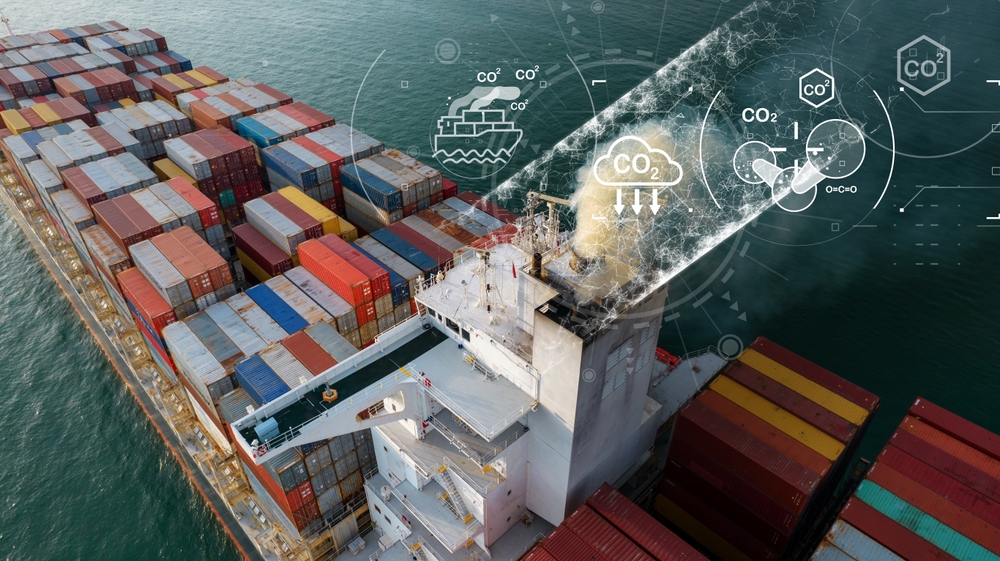The world’s largest emissions trading scheme comes into force on the 1st of January 2024. But what does the entry into force of the ETS really change for maritime transport?
Centrimex, sea and air freight forwarder, explains the impact of this measure on import-export and sea freight operations. Would you like to ship by sea from, to or via the European Union at the best price and under the best conditions?
What is the EU ETS?
In short, from 2024 onwards, shipping companies will join the European Union Emissions Trading Scheme (EU ETS), sometimes referred to as the « European carbon market ». Shipping companies will therefore be subject to the EU Emissions Trading Scheme (ETS). They will be authorised to generate as much greenhouse gas as the number of allowances they hold, and as time goes by, the price of these allowances will increase.
A scheme set up by the EU Council for greener shipping.
The European Union Emissions Trading Scheme (or EU ETS) aims to achieve a sustainable reduction in greenhouse gas emissions in line with the targets set by the Council and the European Parliament.
These objectives are ambitious:
– 43% reduction in gas emissions by 2030, compared with 2005
-62% reduction in greenhouse gas emissions by 2050, compared with 2005
Decarbonising international maritime transport is an ambitious but necessary goal in the face of climate change.
Who is impacted by the ETS?
This system applies to container ships on intra-European commercial voyages, departing from and/or arriving at a European port. Ships travelling through the ports of Tangier Med and Port Saïd are also concerned, to avoid the relocation of freight from near Europe.
100% of emissions will be taken into account for a journey between 2 EU ports, such as Antwerp and Rotterdam. If the journey is to a destination outside Europe, the calculation will be proportional. On a Hamburg – Houston route, for example, 50% of GHG emissions will be subject to the European carbon quota system.
A concrete example of the application of the ETS system
Each company subject to the ETS can freely buy, sell or trade its ETS allowances on a financial market.
If, in 2025, a shipping operator generates the equivalent of 1 000 tonnes of CO2, it must buy 1 0000 allowances at auction on the European Energy Exchange (EEX), and then pay these allowances into the European Union registry before 30 September 2026. If they consume fewer allowances than they had purchased in their shipping or trading account, they can sell them on a secondary market.
If it pollutes more than expected and does not have enough allowances to cover its gas emissions, the operator will have to pay a heavy fine and will have to buy the missing allowances and return them to the European Union.
Financial implications for shipping companies and exporters
Since they will be subject to the ETS from 2024, some shipping companies are going to open their shipping operator holding accounts as soon as possible. These costs are likely to be passed onto the ocean freight rate (shipper) as well as to the entity responsible for operating the vessel (carrier).
Non-financial penalties for non-compliance
EU Member States will be able to vote on and apply non-financial sanctions against shipowners.
For example, a State could decide to detain ships until the quotas have been repaid or, on the contrary, refuse to allow them to enter its ports, which in both cases would lead to delivery delays, complications and even additional costs in the event of emergency transhipment or last-minute modal shifts.
How much does a general EU quota cost?
The price of a general EU quota (or EUA) is not fixed. It depends on the results of the ETS quota auctions.
Shipping companies, aircraft operators, the electricity sector and energy-intensive industries such as oil refineries, steelworks, cement, glass and paper production are all competing on this Europe-wide auction system.
Each year, the cap (the total number of authorised quotas) will decrease. The auction price will rise as a result of scarcity, since there will be so many players in the shipping and industry sectors. The price of ETS allowances will therefore be determined by supply and demand.
This carbon surcharge will have an impact on sea freight costs.
Some shipping companies are already considering a surcharge to offset this new expense. Each shipowner has its own calculation system, which may evolve over time. The ETS surcharge will be applied to the containers and services concerned and will appear on the Centrimex quotations.
How do we know how much CO2 a shipping company generates ?
Greenhouse gas emissions (carbon dioxide CO2, but also methane CH4 and nitrous oxide N2O) from cargo ships, container ships and other vessels will be verified by national accreditation bodies in EU Member States. Shipping companies will be able to choose their ship’s auditors regardless of the ship’s flag, the location of their head office or the auditor’s country of origin.
The European Union will publish the names of European and international shippers who will not pay their carbon tax by exceeding their quotas.

Rethinking international transport in the age of carbon tax
A new, separate ETS will soon be introduced for the fuel, construction and road transport sectors.
Simply shifting freight from sea to air or road is not enough to make savings. It will be necessary to really rethink routes, logistics « and best practices »
As a maritime and multimodal freight forwarder, Centrimex can help you set up your entire supply chain.
You want send an urgent shipment at a controlled cost ? Rethink your supply chain to cut costs ?
Contact our teams.




